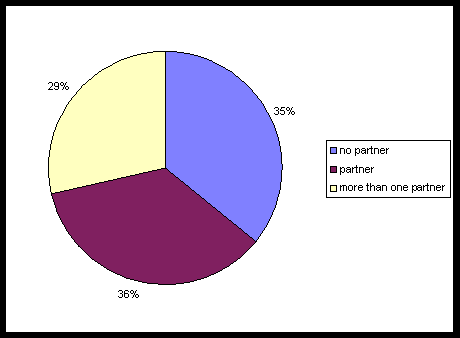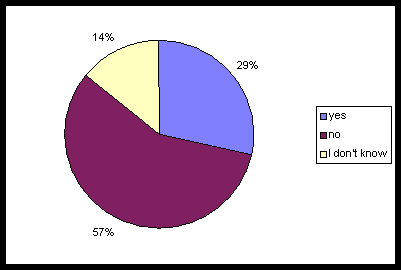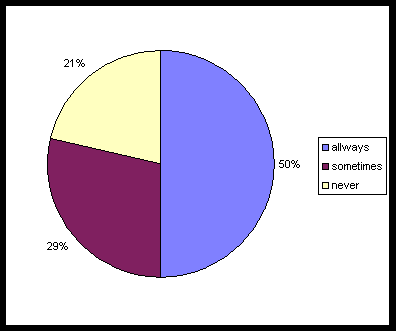Archive for Sexology
"Socio-cultural Aspects of AIDS Prevention for Prostitutes in Bulgaria"
by Dr. Michail A. Okoliyski
National Center of Public Health, Sofia
Presented at the 5th EFS Congress, Berlin 2000
Contents
- Epidemiology of HIV in Bulgaria
- The study: Concept; Methods; Results
- Discussion
I would like to start with a little story: While I was starting to work on this presentation, I read in my daily Bulgarian newspaper some information about a big congress on the problems of commercial sex work (CSW) in Berlin with two thousand sex workers from twenty three countries.
"We are not ashamed of our work" - was the motto of the activists - "we just want to be protected by all the power of the law like all other professionals".
According to the statement of the organizers, society needs prostitution as much as any other form of work. Although the story in the newspaper was presented in a neutral way, prostitution is probably one of the most stigmatized and discriminated forms of money making in Bulgaria.
Introduction
At the end of 1999, the documented number of individuals infected with HIV in Bulgaria was remarkably low (240 documented cases: Table 1). The cases were predominantly infected by heterosexual contacts and officially no person from this statistic was a commercial sex-worker. But given the estimated large unofficial number of sex workers (men and women) in the large cities (Sofia, Plovdiv) and on the Black Sea coastal tourist resorts and their suspected high rates of sexually transmitted diseases (STDs), there is a great potential for the spread of HIV infection. New studies show also a high number of young people, who inject hard drugs, and, in addition to the bad economical situation in Bulgaria, health experts see the danger of Hepatitis and HIV infection spreading in this population.
Table 1: HIV-prevalence in Bulgaria 1986 - 1994) and the ways of transmission.
|
Way of transmission |
|
1986 |
1987 |
1988 |
1989 |
1990 |
1991 |
1992 |
1993 |
‘94* |
All |
|
Hemophilia
|
4 |
5 |
2 |
11 |
|||||||
|
Blood |
Hemodialysis
|
1 |
1 |
2 |
|||||||
|
Med. Appliance
|
1 |
1 |
|||||||||
|
Sexual |
Hetero-
|
18 |
29 |
13 |
3 |
6 |
11 |
8 |
5 |
93 |
|
|
contacts |
Homo- and. bi-
|
1 |
4 |
4 |
1 |
5 |
1 |
16 |
|||
|
Perinatal |
|
1 |
1 |
||||||||
|
All for each year |
|
4 |
24 |
35 |
17 |
7 |
6 |
12 |
13 |
6 |
124 |
- end of 1994
For effective AIDS prevention in target groups, health professionals need insights into the behavior patters and motives which are hiding behind the epidemiological data. In order to gain a better understanding of this knowledge, attitudes and practices (in addition to my dissertation study on the Humboldt-University in Berlin under the scientific guidance of Prof. E. J. Haeberle), face-to-face interviews were made. This paper is a result of the analysis of an initial survey of 61 people with homo-, bi-, and heterosexual behavior and people, who inject drugs. The study was made in the period 1997-1998 in the capital city of Bulgaria, Sofia.
In our questionnaire we confront our respondents also with questions about selling sex. About one third of the group with bisexual behavior, the same part from the people, injecting drugs and 25% of the people with homosexual behavior reported experience as sex workers.
Method
Data collection
The subjects from each target group were contacted by a multiple snowball sampling technique. The snowball sampling technique, widely used to recruit respondents from unknown populations, uses an initial contact from the population of interest to bring further eligible subjects to a study from among his or her associates. Each respondent will in turn be encouraged to bring to the study others they may know who fit the study's eligibility criteria. Concern about anonymity, the length of the interview and the unwillingness of some people to talk about their sexuality to outsiders were the main reasons for refusal. Respondents were not compensated monetarily. The study was pre-tested and revised.
Training of the interviewers was conducted before data collection was initiated. The survey assessed the following information:
- Sociodemographic variables,
- Attitudes toward own sexuality,
- Safe and unsafe sexual practices,
- Evaluation of condoms,
- Attitudes toward HIV/AIDS
Results
Sociodemographic variables
In our sample, the group of male sex workers 86% (eighty six percent) prevailed. Reported ages ranged from 20 to 40 years with an average of 27,5 years. All of them worked in the largest city of Bulgaria, Sofia. Because no background information is available on the overall population of sex workers in Bulgaria, it is unknown whether the respondents form a representative sample. No non-Bulgarian sex workers were recruited. Research involving this group will require more intensive efforts.
A significant majority of the respondents was without a partner-relationship 35% or has more than one partner 29% (Table 2). Here exist the danger by about 60% of the CSW of STDs and HIV transmission on their private partners.
In this connection, the circumstances surrounding CSWs initial entry into sex work were varied, but a common theme was that of being divorced or just not having a partner, resulting in economic hardship and the need to find work to support children or other family. Unmarried respondents often reported loss of boy- or girlfriend or family problems.
Table 2: Partner situation
Attitudes toward own sexuality
The sex workers, male and female, were very ambivalent toward their own sexuality. 57% of the sample were negative about their own sexuality. In our opinion this statistic shows, that they did not regard prostitution as a profession. This is because the sexual emancipation in Bulgaria started only recently - a few years ago after the crash of the communist's regimes 1990. As we know from other researchers (Kleiber, Dannecker, Morse 1991) two types of CSWs do appear to be at risk of HIV transmission. In the first place, those without a self-identity as sex workers who allow themselves sexual feelings during commercial contacts seem prone to ignore safe practices. And in the second place, the isolation, stigmatization, and the absence of social support and control may discourage condom use. Anyway, this lower degree of institutionalization and professionalization of prostitution may result in unsafe sex practices.
Table 3: Is your sex normal?
Safe and unsafe sexual practices
Detailed data were collected from respondents concerning the types and safety of the sexual contacts. CSWs were asked about their specific sexual acts. The vast majority of the women performed mostly coitus, masturbation, cunnilingus and fellatio, but they used condoms only occasionally -half of the female CSWs performed coitus and fellatio without protection.
They represent diverse segments of the population, who in turn are characterized by inconsistent and low frequency of condom use, high prevalence of STDs and inadequate knowledge of the basic concepts of HIV transmission and prevention.
Table 4: Sexual practices with and without condom during the last commercial sex relation*
Sexual practices with other gender partners
|
Not practiced |
With condom |
Without condom |
|
|
Vaginal intercourse (Coitus) |
11,1% |
44,1% |
44,4% |
|
Masturbation/Body massage |
22,2% |
0% |
77,8% |
|
Cunnilingus |
22,2% |
22,2% |
55,6% |
|
Petting |
37,5% |
12,5% |
50% |
|
Fellatio |
44,4% |
11,1% |
44,4% |
|
Anal sex |
55,6% |
44,4% |
0% |
|
Group-Sex |
55,6% |
33,3% |
11,1% |
|
Sado-Maso Sex |
100% |
- |
- |
Sexual practices with same gender partners
|
Not practiced |
With condom |
Without condom |
|
|
Masturbation |
18,2% |
9,1% |
72,7% |
|
Fellatio active |
18,2% |
36,4% |
45,5% |
|
Fellatio passive |
18,2% |
54,5% |
27,3% |
|
Group-Sex |
18,2% |
72,7% |
9,1% |
|
Anal sex active |
27,3% |
63,6% |
9,1% |
|
Anal sex passive |
27,3% |
63,6% |
9,1% |
|
Sado-Maso Sex |
81,8% |
9,1% |
9,1% |
*confirmative answers.
45,5% of the male CSWs were willing to perform fellatio without protection. Other sexual practices were also reported. 72,7% reported anal sex during the last sexual contact, but it was unsafe in only 9,1% of the cases.
Our study shows that there is a large gap between commercial sex work with the same and with the other gender. The male prostitutes have higher levels of knowledge of AIDS and report higher rates of condom use with their clients. However, they are also at risk of becoming infected with HIV and, along with their clients, and this could contribute to the spread of the virus throughout Bulgaria.
Attitudes toward condoms
A series of questions were asked to elicit beliefs and attitudes about condoms. In fact, the opinion of the CSWs of condoms was predominantly negative. Frightening: Nearly half of the respondents report, that when they use alcohol/drugs, they don't care about AIDS and 35,7% said they usually don't use condoms. Nearly every third CSW found using a condom lessened the sensation and was unpleasant. Numerous other objections were listed: no fear from AIDS (14,3%), sex with condoms is not a real sex (21,4%), loss of erection (7,7%), Only one third of the respondents cited AIDS and other STDs, as reasons to use condoms.
Table 38: Attitudes to condoms
|
When I use alcohol/drugs, I don't care about AIDS. |
42,9% |
|
Condoms lessen sensations. |
35,7% |
|
Usually I don't use condoms. |
35,7% |
|
I use condoms for safety from STDs/AIDS. |
28,6% |
|
Sex with condoms is not a real sex. |
21,4% |
|
Sex with condoms doesn't give pleasure. |
21,4% |
|
I find condoms disgusting and unpleasant. |
14,3% |
|
No fear from AIDS-infection. |
14,3% |
|
I've never used condoms. |
14,3% |
|
I fear I will lose my erection. |
7,7% |
Condoms were not only used inconsistently, but they also are not always available for the CSWs. The respondents did not seem to consider accessibility or cost to be important obstacles to condom use, but nearly 21% reported that they never have condoms when going out and 29% said condoms were sometimes unavailable when needed. 50% always had condoms.
Table : How often do you have condoms when you are going out?
Discussion
Our study investigated AIDS knowledge, risk behavior, attitudes toward specific groups and condom use among two groups of CSWs in Sofia, and found them to differ in their sexual orientation, levels of knowledge and attitudes of AIDS and their level of condom use. Both groups, however, are at risk of transmission of HIV. Thus, it is critical that interventions targeted to specific groups of CSWs and clients be undertaken as soon as possible.
Being a CSW makes a person vulnerable to the loss of social services and expulsion from social support systems such as the family. The stigma associated with being a CSW may make it impossible for these persons to develop and maintain safe lifestyles. Thus, it is extremely difficult for people to identify themselves as prostitutes.
The involvement of pimps or Mafia bosses in condom promotion is important as they often have great influence over CSW's practices. Social marketing of high quality condoms may also strengthen clients' willingness to use condoms regularly.
Outreach programs also must be sensitive to these facts and to cultural differences. HIV educational models that have worked with the CSWs in Western countries will not work with this population. Personal relationships and networking are necessary components of outreach programs for all CSWs. Only such an approach can establish the trust needed for effective AIDS prevention.
I'm grateful for the assistance that we have received from Robert Koch-Institut and Humboldt-University for this project. I would like to thank personally Prof. Erwin Haeberle for his suggestions and encouragement and for inviting me here, at this wonderful conference, on which I'm for the first time, to present this paper.
Finally, I would like to thank you for your attention.
page up


